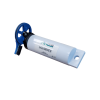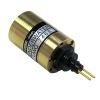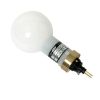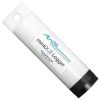PME miniPAR Logger
Features
- Submersible up to 100 meters
- PAR, orientation, and temperature sensors
- Anti-fouling wiper available
- Expedited repair and warranty service
- Lifetime technical support
- More
Overview
The PME minPAR contains a tilt sensor to ensure proper orientation and a temperature sensor. Data is recorded on an internal SD card. The miniPAR is powered by 2 AA batteries and can be fitted with an anti-fouling miniWIPER to protect long-term data accuracy.
Measuring Photosynthetically Active Radiation
The miniPAR is fitted with an LI-192 Underwater Quantum Sensor manufactured by LI-COR. The sensor uses a silicon photodiode and glass optical filters to create a uniform sensitivity to light wavelengths in the 400-700nm range. It measures PAR from all angles in one hemisphere. PAR is a key indicator for understanding nutrient loading, photosynthesis, algae blooms, or other biological, chemical, or physical processes.
Battery Powered
PME is confident that the logger can continue collecting measurements for over one year before the batteries need to be replaced at a sampling interval of one minute. The miniPAR is constructed from strong Delrin plastic that does not easily crack or break.
Embedded Tilt Sensor
The miniPAR is unique among similar loggers in that it contains a tilt sensor to measure the orientation of the device. Since PAR measurement accuracy is dependent upon the sensor being pointed toward the water surface, the tilt sensor will alert the user if the sensor is rotated in a particular direction.
PME Software Included
PME software is provided with every miniPAR logger and can be found on the included SD card when it is connected to a computer. The software creates visual plots to read PAR measurements easily and allows the user to set the internal clock and sample rate.
In The News
Thin Ice: Year-Long Monitoring in Missouri Reservoirs
The value of multi-lake studies is well understood by international organizations like the Global Lake Ecological Observatory Network (GLEON) and the scientists who work tirelessly to provide data to the larger network. Rebecca North, an associate professor at the University of Missouri-Columbia , is one of many researchers involved in multi-lake research initiatives and conducting research locally in her home state. Having been born and raised on the shore of Lake Ontario, North grew up in a community that revolved around water. She also saw firsthand one of the worst water quality bodies of the world, the Bay of Quinte, decline throughout her lifetime.
Read MoreFrom Paddles to Phytoplankton: Studying Vermont’s Wildest Lakes
For six months of the year, Rachel Cray, a third-year PhD student at the Vermont Limnology Laboratory at the University of Vermont, lives between a microscope and her laptop, running data. For the other six months, she is hiking and canoeing four of Vermont’s lakes, collecting bi-weekly water samples. Cray studies algal phenology across four lakes in Vermont, US, that have low anthropogenic stress—or in other words, are very remote. Funded by the National Science Foundation Career Award to Dr. Mindy Morales, the lakes Cray researches part of the Vermont Sentinel Lakes Program, which studies 13 lakes in the area and, in turn, feeds into the Regional Monitoring Network, which operates in the Northeast and Midwest US.
Read MoreReimagining Water Filtration: How Monitoring and Science Enhance FloWater Filtration Systems
Over 50% of Americans think their tap water is unsafe , according to the Environmental Working Group (EWG). Other recent surveys have found that number to be as high as 70% of persons surveyed. Whether due to increased public awareness of water quality issues or confusion about how municipal water sources are regulated, there is a clear distrust of tap water in the United States. According to industry expert Rich Razgaitis, CEO and co-founder of the water purification company FloWater, this issue creates a damaging cycle. Razgaitis explained that the health and environmental problems associated with contaminated water aren’t the only issues. As people become increasingly aware that some tap water is unsafe, they resort to bottled water.
Read More
















